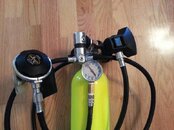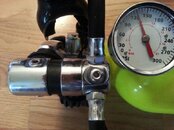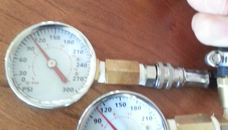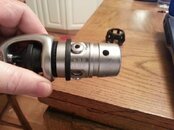UPDATE on the DIY SPEC Boot
Well, I'm ten dives into this SPEC boot now.
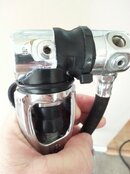
Everything's going great! Per my previous post, I added a little Tribolube after three dives, but I've left it alone since then. Down to 100 feet on a wreck dive at 50 degrees without a problem.
That said, I also tested the plain inner tube fitted snugly around the holes on an otherwise wasted low-vis day in Monterey. As posted previously, I put a separate Mk10 tuned to an IP of ~126 on a pony bottle with a downstream unbalanced Pacer, a center-balanced D-series, and took it with me as my "sidemount spare gas."

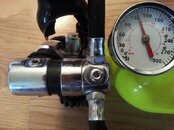
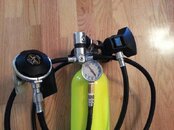
It proved why scuba regulators are designed the way they are, and why Peter Wolfinger's Regulator Savvy is the theoretical Bible. By the time I reached 33 ft, my cheap Chinese IP gauge (which flooded immediately and was a great way to measure what happened on descent) had already dropped to around 115 psi. It wasn't a drop of exactly 14.7 psi, so the inner tube was evidently flexing a little. As I took it lower (not breathing on it yet, by the way), it went down another 12psi by the time I reached 65 feet. I took a suck from the Pacer at an IP of 102 psi or so, and although I thought I could tell it was stiffer breathing, it might have just been my imagination. The D-series reg didn't notice the difference with that IP. I left it on the bottom and came back in a half hour to bring it to the surface. IP had increased to ~110.
And when I took the reg apart after the dive, it was obvious why the IP increased over 30 min of sitting there: there were a few drops of sea water in the environmental chamber, though not much. So, the inner tube only flexed into the holes enough to give me a few psi worth of depth change. The IP should have stayed constant at 126, but instead, the drop matched the increase in pressure at depth almost completely. A very stiff roof over those holes, despite the thin and seemingly flexible bicycle inner tube. Then, it rose as the boot leaked sea water into the chamber over 30 min.
Conclusion? Having a poorly-flexible, zero-volume "SPEC boot" covering the environmental holes is not safe. IP drops with depth as expected from the physics, and it doesn't keep the reg clean inside either. In fact, the salt water I found would now be trapped inside until you take it apart, as the bicycle tire is pretty tight around the holes.
On the other hand, the flexible roof large tire boot that I did the wreck dive with gives with each breath, as well as flexing visibly when turning the reg on and off. As you can see from the pics, it leaks a little bit of Tribolube, but after ten dives and only 0.5 cc added, I'm happy.
Someone else asked about using the Atomic boot. Here's the deal:
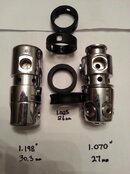
3mm difference in the outside diameter of the environmental chamber. The ring is 1mm smaller diameter than the Atomic chamber OD. So, when fitted on the Mk10, the Atomic boot doesn't like that much diameter difference (compared to the 1mm of diam change with an Atomic reg):
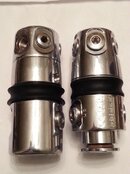
As you can see, the roof is almost completely collapsed when mounted on a SP Mk10. More important, the firm sidewalls of the boot pull away from the groove a bit (not easily visible in the photo) so it will not perform the same function reliably. If the boot on the Atomic looks collapsed almost the same to you, it's because I just fitted it on an empty reg, and there is no grease behind it.
So if you want to seal a Mk10, a reasonably easy solution right now seems to be a 29" balloon tire inner tube with a designed tube diameter of around 2.1"
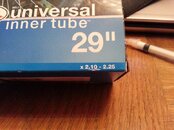
zip-tied on one side of the groove after filling the chamber with your grease of choice. In a couple of years, I'll take my Mk10 apart and let you know what's inside the chamber. But I'm confident that my ol' Mk10 will make it as long as Atomic's 2yrs/300 dives service interval. Bad on Scubapro for discontinuing the SPEC boot.
As for just sealing your environmental chamber holes with an inner tube - unsafe! Thus endeth the sermon.



